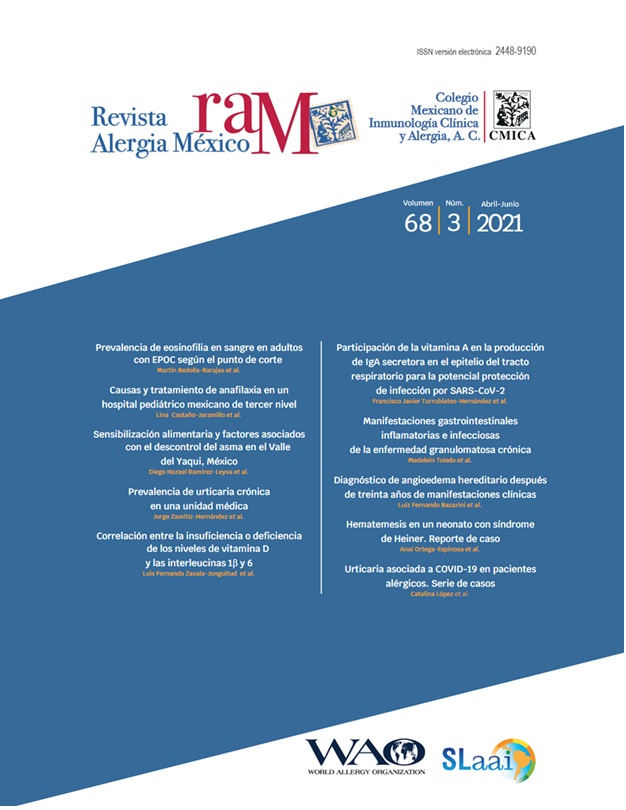Resumen
Objetivo: Caracterizar clínicamente los eventos de anafilaxia en un hospital pediátrico de tercer nivel.
Métodos: Se revisaron 1148 expedientes clínicos. Finalmente, se analizó la información correspondiente a 35 episodios de anafilaxia en 20 pacientes; tres de ellos con múltiples episodios de anafilaxia.
Resultados: La edad mediana de los episodios de anafilaxia fue de 11 años (rango intercuartilar 10 años, Q1 = 5, Q3 = 15), con predomino en adolescentes de 12 a 17 años y del sexo femenino. Las manifestaciones clínicas más frecuentes fueron las cutáneas (86 %), seguidas de las respiratorias (83 %), las cardiovasculares (74 %) y las gastrointestinales (46 %). En tres casos se documentó paro cardiorrespiratorio, pero no hubo casos de mortalidad asociada a anafilaxia. Los principales desencadenantes fueron alimentos (34 %), medicamentos (29 %), inmunoterapia para alérgenos (14 %) y látex (11 %). En los pacientes con anafilaxia perioperatoria el comportamiento clínico fue grave. La adrenalina se utilizó en 27 de los 35 episodios (77 %), en 11 de ellos fue el tratamiento de primera elección. Los corticosteroides sistémicos fueron los medicamentos más frecuentemente utilizados, seguidos de la adrenalina y los antihistamínicos.
Conclusiones: El uso de adrenalina, pilar del tratamiento de anafilaxia, es subóptimo; con uso preferente de medicamentos de segunda línea como los corticosteroides. Se requieren protocolos para diagnóstico y tratamiento de anafilaxia, aunado a una educación continua del personal de salud.
Referencias
Moore LE, Kemp AM, Kemp SF. Recognition, treatment, and prevention of anaphylaxis. Immunol Allergy Clin North Am. 2015;35(2):363-374. DOI: 10.1016/j.iac.2015.01.006
Shaker MS, Wallace DV, Golden DBK, Oppenheimer J, Bernstein JA, Khan DA, et al. Anaphylaxis-a 2020 practice parameter update, systematic review, and Grading of Recommendations, Assessment, Development and Evaluation (GRADE) analysis. J Allergy Clin Immunol. 2020;145(4):1082-1123. DOI: 10.1016/j.jaci.2020.01.017
Douglas DM, Sukenick E, Andrade WP, Brown JS. Biphasic systemic anaphylaxis: an inpatient and outpatient study. J Allergy Clin Immunol. 1994;93(6):977-985. DOI: 10.1016/s0091-6749(94)70044-3
Cardona V, Álvarez-Perea A, Ansotegui IJ, Arias-Cruz A, González-Díaz SN, Latour-Staffeld P, et al. Manejo de la anafilaxia en América Latina: situación actual. Rev Alerg Mex. 2017;64(2):171-177. DOI: 10.29262/ram.v64i2.250
Sampson HA, Muñoz-Furlong A, Bock SA, Schmitt C, Bass R, Chowdhury BA, et al. Symposium on the definition and management of anaphylaxis: summary report. J Allergy Clin Immunol. 2005;115(3):584-591. DOI: 10.1016/j.jaci.2005.01.009
Muraro A, Roberts G, Worm M, Bilò MB, Brockow K, Fernández-Rivas M, et al. Anaphylaxis: guidelines from the European Academy of Allergy and Clinical Immunology. Allergy. 2014;69(8):1026-1045. DOI: 10.1111/all.12437
Sampson HA, Muñoz-Furlong A, Campbell RL, Adkinson NF, Bock SA, Branum A, et al. Second symposium on the definition and management of anaphylaxis: summary report--Second National Institute of Allergy and Infectious Disease/Food Allergy and Anaphylaxis Network symposium. J Allergy Clin Immunol. 2006;117(2):391-397. DOI: 10.1016/j.jaci.2005.12.1303
Actualizaciones de la CIE-10 [Internet]. Organización Panamericana de la Salud/Organización Mundial de la Salud; 2013. Disponible en:https://www3.paho.org/hq/index.php?option=com_content&view=article&id=9178:2013-actualizaciones-cie-10&Itemid=40350&lang=es
Yu JE, Lin RY. The epidemiology of anaphylaxis. Clin Rev Allergy Immunol. 2018;54(3):366-374. DOI: 10.1007/s12016-015-8503-x
Motosue MS, Bellolio MF, van Houten HK, Shah ND, Campbell RL. Increasing emergency department visits for anaphylaxis, 2005-2014. J Allergy Clin Immunol Pract. 2017;5(1):171-175. DOI: 10.1016/j.jaip.2016.08.013
Campbell RL, Hagan JB, Manivannan V, Decker WW, Kanthala AR. Bellolio MF, et al. Evaluation of national institute of allergy and infectious diseases/food allergy and anaphylaxis network criteria for the diagnosis of anaphylaxis in emergency department patients. J Allergy Clin Immunol. 2012;129(3):748-752. DOI: 10.1016/j.jaci.2011.09.030
Samady W, Trainor J, Smith B, Gupta R. Food-induced anaphylaxis in infants and children. Ann Allergy Asthma Immunol. 2018;121(3):360-365. DOI: 10.1016/j.anai.2018.05.025
Simons FER. Anaphylaxis. J Allergy Clin Immunol. 2010;125(2 Suppl 2):S161-S181. DOI: 10.1016/j.jaci.2009.12.981
Grabenhenrich LB, Dölle S, Moneret-Vautrin A, Köhli A, Lange L, Spindler T, et al. Anaphylaxis in children and adolescents: the European Anaphylaxis Registry. J Allergy Clin Immunol. 2016;137(4):1128-1137.e1. DOI: 10.1016/j.jaci.2015.11.015
Tejedor-Alonso MA, Moro-Moro M, Múgica-García MV. Epidemiology of anaphylaxis: contributions from the last 10 years. J Investig Allergol Clin Immunol. 2015;25(3):163-175; quiz follow 174-175. Disponible en: http://www.jiaci.org/issues/vol25issue3/1.pdf
Simons FER, Ardusso LR, Bilò MB, Cardona V, Ebisawa M, El-Gamal YM, et al. International consensus on (ICON) anaphylaxis. World Allergy Organ J. 2014;7(1):9. DOI: 10.1186/1939-4551-7-9
Wang J, Sampson HA. Food anaphylaxis. Clin Exp Allergy. 2007;37(5):651-660. DOI: 10.1111/j.1365-2222.2007.02682.x
Hompes S, Köhli A, Nemat K, Scherer K, Lange L, Rueff F, et al. Provoking allergens and treatment of anaphylaxis in children and adolescents--data from the anaphylaxis registry of German-speaking countries. Pediatr Allergy Immunol. 2011;22(6):568-574. DOI: 10.1111/j.1399-3038.2011.01154.x
Turner PJ, Jerschow E, Umasunthar T, Lin R, Campbell DE, Boyle RJ. Fatal anaphylaxis: mortality rate and risk factors. J Allergy Clin Immunol Pract. 2017;5(5):1169-1178. DOI: 10.1016/j.jaip.2017.06.03

Esta obra está bajo una licencia internacional Creative Commons Atribución-NoComercial 4.0.
Derechos de autor 2021 Revista Alergia México





